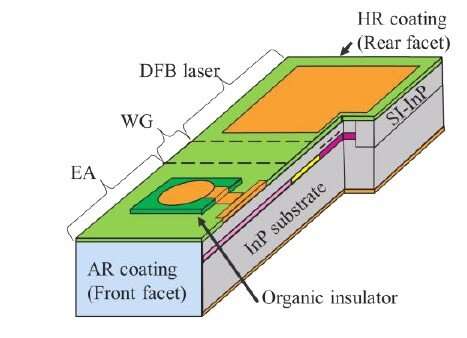This article has been reviewed according to Science X's editorial process and policies. Editors have highlighted the following attributes while ensuring the content's credibility:
fact-checked
trusted source
proofread
New laser lays groundwork for next-generation ethernet technology

Scientists from Japan have developed a new type of distributed feedback (DFB) laser and have shown that it can be used to transmit data at speeds of 200 Gb/s over a record distance of 10 kilometers. This research could help advance network technology that would allow internet data centers to handle unprecedented levels of data.
Kazuki Nishimura, an optical engineer in the Datacom Business Unit of Lumentum Japan, will present the new research at the Optical Fiber Communication Conference (OFC), taking place March 5–9 2023 in San Diego, California, U.S..
"The research contributes to the development of next-generation data centers for 800G and 1.6T ethernet. Particularly, the new technology suggests electro-absorption modulators with integrated distributed feedback (EA-DFB) lasers can work even 10-km transmission using conventional PAM4 (pulse amplitude modulation) technology, which is defined as a simple intensity-modulation direct-detection (IM/DD) scheme," said Nishimura.
As communication traffic continues to increase, there is a growing focus on implementing next-generation ethernet technology, such as 800G and 1.6T ethernet, to help data centers meet growing demands. Although the same PAM4 technology used for 2-km transmission in today's 400G ethernet is being considered for 800G, new technology is needed to achieve data transmission over longer distances for interconnections between data center regions or campuses.
In the new work, the researchers developed a lumped electrode electro-absorption (EA) modulator DFB laser to achieve longer distances. They first used the new laser to demonstrate 5-km transmission of 225-Gb/s PAM4 using the coarse wavelength division multiplexing (CWDM) wavelength band under 50°C operation. They also used the laser for 10-km transmission of 225-Gb/s PAM4 at 1293.5 nm. This wavelength exhibits less chromatic dispersion than the wavelength range assigned to CWDM, the technology typically used to simultaneously send multiple optical signals over an optical fiber. Chromatic dispersion can cause degradation in the optical signal and is more problematic for longer transmission distances.
For all the experiments, the new laser exhibited low transmitter and dispersion eye closure quaternary (TDECQ) values, indicating solid transmitter performance. The researchers say that their results demonstrate the potential of the lumped electrode EA-DFB laser as a light source for 800G ethernet technology, including 10-km applications. It could also be useful for longer reach 5-km CWDM4 applications.
"The traffic in data centers is significantly growing annually as high-resolution video-streaming services, such as 4k and cloud applications. These results show our EA-DFBs are a promising optical light source to realize the upcoming 800GbE applications," said Nishimura.




















